Today’s Current Affairs: 19th Jun 2023 for UPSC IAS exams, State PSC exams, SSC CGL, State SSC, RRB, Railways, Banking Exam & IBPS, etc
Table of Contents
Dugdh Sanakalan Sathi Mobile App:

The Union Minister of Heavy Industries unveiled the ground-breaking “Dugdh Sanakalan Sathi Mobile App” at Mussorie, Uttarakhand.
- Dugdh Sankalan Sathi App is designed and developed by Rajasthan Electronics & Instruments Limited (REIL), a “Mini Ratna” Central Public Sector Enterprise under the Ministry of Heavy Industries.
- It aims to improve the quality of milk, foster transparency among stakeholders, and streamline operations at the grassroots village level, including Milk Cooperative Societies.
- This will inform all services to milk producers in English, Hindi, Punjabi, Telugu and other languages
- App include:
- Increased transparency among stakeholders
- Online monitoring of daily milk poured at Milk Cooperative Societies
- Real-time milk price updates from the cloud server, ensuring transparency and eliminating human errors
- Direct beneficiary transfers of milk payments and government subsidies to the milk producers’ bank accounts through the app
- Push notifications for milk collection to the milk producers’ app
National Time Release Study (NTRS) 2023 Report:
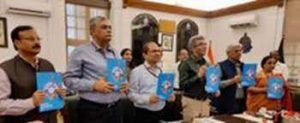
The chairman of the Central Board of Indirect Taxes and Customs (CBIC) along with other Members of the Board released the National Time Release Study (NTRS) 2023 report.
- National Time Release Study (NTRS) 2023 report is a performance measurement tool.
- It aims to present a quantitative measure of the cargo release time at the Customs station.
- It also measures the domestic clearance in case of imports and the arrival of the cargo at the Customs station to the eventual departure of the carrier in case of exports.
- The study included seaports, air cargo complexes (ACCs), inland container depot (ICDs) and integrated check posts (ICPs) which handles the maximum per cent of bills of entry in the country.
Highlights of the report:
- It reaffirms the ‘Path to promptness’e. comprising advance filing of import documents enabling pre-arrival processing, risk-based facilitation of cargo and benefits of trusted client programme.
- Cargoes wherein all the three features under the Path to Promptness are combined, achieve the National Trade Facilitation Action Plan (NTFAP) release time target across all port categories.
- It has placed a much greater focus on the measurement of export release time.
- It recognises the distinction between regulatory clearance also referred to as customs release, which gets completed with the grant of Let Export Order (LEO) and the wider aspect of physical clearance which occurs on completion of logistics processes with the departure of the carrier with the goods.
Soul Of Steel Himalayan Challenge:
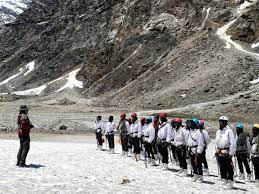
A first-of-its-kind event, the ‘Soul of Steel Himalayan Challenge’ was recently conducted in the forward areas of the Garhwal Himalayan region.
- The challenge supported by the Indian Army in collaboration with Conquer Land Air Water (CLAW) Global was launched by defence minister on January 14 at Dehradun.
- The campaign was initiated on the 120th Raising Year of the 9 (Independent) Mountain Brigade.
- It was based on the lines of the ‘Ironman triathlon’, a long-distance triathlon held in Europe which tests an individual’s physical capabilities.
- The initiative is aimed at enabling life skill training and youth development. It is also expected to boost global promotion of adventure tourism in Uttarakhand.
- It was a unique blend of specialised skills, including high altitude mountaineering, extreme cold survival, psychological and physical endurance.
- The challenge opened the domain of niche military skills to an average person, who wishes to challenge their physical and psychological limits.
- It attracted interest from 1,401 (including 94 women) highly skilled athletes, adventure sports enthusiasts and armed forces aspirants.
- These applicants were put through a gruelling two-stage screening process, of which only 23 including two women were finally chosen to undergo a 10-week extensive training in endurance, mountaineering, survival and rescue skills under a joint team of experts from the armed forces and CLAW Global.
- The participants were trained to operate beyond the assumed limits of their body, to discover the limitless realms of their mind, consciousness and spirit.
- In the final phase of the challenge, 18 ‘Soul of Steel’ warriors set out on a challenge to compete as teams of three along the rugged mountainous terrain of the Garhwals, at an altitude of 17,000 feet and covered a distance of 65 km through glaciers, ice walls, rock faces and snow-capped Himalayan peaks.
- The challenge tested their self-sustained mountain climbing, survival, navigation skills, psychological endurance and physical toughness.
India To Be a Part Of Artemis Team:

A top NASA official recently said that India needs to be a part of the Artemis team, which brings like-minded countries together on civil space exploration.
- The Artemis Accords are a non-binding set of principles designed to guide civil space exploration and use in the 21st century.
- These principles will help to ensure the maintenance of a safe and predictable outer space environment.
- NASA, in coordination with the U.S. Department of State, established the Artemis Accords in 2020, together with seven other founding member nations.
- Artemis Accords signatories as of May 30, 2023: Australia, Bahrain, Brazil, Canada, Colombia, Czech Republic, France, Israel, Italy, Japan, Luxembourg, Mexico, New Zealand, Nigeria, Poland, the Republic of Korea, Romania, Rwanda, Saudi Arabia, Singapore, Spain, Ukraine, the United Arab Emirates, the United Kingdom, and the United States.
- With the Artemis programme, NASA aims to land humans on the moon by 2024, and it also plans to land the first woman and first person of colour on the moon.
- With this mission, NASA aims to contribute to scientific discovery and economic benefits and inspire a new generation of explorers.
4th National Water Awards:

The Vice President of India, Shri Jagdeep Dhankhar, conferred the 4th National Water Awards, 2022 at Vigyan Bhawan in New Delhi
- 41 winners, including joint winners across 11 categories were awarded for their exemplary work in the field of water conservation and management.
- Each award winner was conferred with a citation and a trophy as well as cash prizes in certain categories.
- The Vice President also launched an animated short film on ‘Piku’, the mascot of National Water Mission for telecast on Doordarshan to spread the message of water conservation.
- The event started with the traditional ‘Jal Kalash’ ceremony.
National Water Awards:
- The first edition of the National Water Awards was introduced by the Department of Water Resources, River Development and Ganga Rejuvenation in 2018.
- They have provided a good opportunity for start-ups as well as leading organizations to engage and deliberate with senior policymakers on how to adopt the best water resources management practices in India.
- These awards have been instituted to recognize and encourage exemplary work and efforts made by States, Districts, individuals, organizations, etc across the country in attaining the vision of a ‘Jal Samriddh Bharat’.
- It covers 11 categories Best State’, ‘Best District’, ‘Best Village Panchayat’, ‘Best Urban Local Body’ etc.
- The award winners in different categories will be given a citation, trophy and cash prize.
- The cash prizes for the 1st, 2nd, and 3rd rank winners are Rs.2 lakhs, Rs.1.5 lakhs, and Rs.1 lakh, respectively.
- Nodal Ministry: Ministry of Jal Shakt
UNSDC Framework 2023-2027:

NITI Aayog and the United Nations in India signed the Government of India – United Nations Sustainable Development Cooperation Framework 2023-2027.
- GoI-UNSDC framework represents the UN development system’s collective offer to the Government of India, in line with the national vision for development, for the achievement of the Sustainable Development Goals, promoting gender equality, youth empowerment and human rights.
- It is built on four strategic pillars derived from the 2030 Agenda – People, Prosperity, Planet and Participation.
- The four interlinked pillars have six outcome areas focusing on Health and Well Being; Nutrition and Food Security; Quality Education; Economic Growth and Decent Work; Environment, Climate, WASH and Resilience; and Empowering People, Communities, and Institutions.
- It will have a specific focus on SDG localisation and South-South cooperation, in line with India’s leadership towards the implementation and acceleration of the SDGs; and India’s championing of South-South cooperation.
- The implementation and monitoring will be co-led by the Government of India and the United Nations, India through a Joint Steering Committee.
Solar Ultraviolet Imaging Telescope:
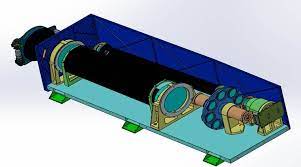
The Solar Ultraviolet Imaging Telescope (SUIT), a unique space telescope developed by Pune’s Inter-University Center for Astronomy and Astrophysics (IUCAA) has been delivered to the Indian Space Research Organisation (ISRO).
- Solar Ultraviolet Imaging Telescope (SUIT) telescope is one of the seven payloads on Aditya-L1.
- It will provide full disk images of the sun in 2000 to 4000 A wavelength range which has never been obtained.
- It will allow us to record images in this wavelength crucial for maintaining the Ozone and Oxygen content in the atmosphere of the Earth.
- It will also measure the UV radiation hazardous for skin cancer.
- It will address fundamental questions such as the existence of a higher-temperature atmosphere above the cooler surface of the Sun and the origin and variation of near-ultraviolet radiation and high-energy solar flares.
- It will help in the measurement of solar radiation from Hard X-ray to Infrared, as well as in-situ measurements of particles in the solar wind, including the Sun’s magnetic field at the L1 point.
- It is expected to last five years.
- ISRO funded the initial Rs 25 crore required for the hardware, a small portion of the overall project.
Aditya-L1 Mission:
- It is India’s first dedicated scientific mission to study the Sun.
- The spacecraft will be placed in a halo orbit around the first Lagrange point, L1, which is 1.5 million km from the Earth towards the Sun.
- A satellite around the L1 point has the major advantage of continuously viewing the Sun without occultation/eclipses.
One Nation One Anganwadi Program:
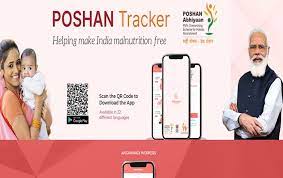
More than 57,000 migrant workers have registered for the special one nation one Anganwadi program on Poshan Tracker App.
- Poshan app will allow migrant workers to access nurseries at their respective locations by using the Poshan Tracker App on mobile phones.
- Poshan Tracker App: The Ministry of Women and Child Development (MoWCD) has launched an application called Poshan Tracker.
- The Poshan Tracker management application provides a 360-degree view of the activities of the Anganwadi Centre.
- The app facilitates efficient service delivery by digitizing and automating the tasks performed by Anganwadi Workers.
- To support their work, smartphones procured through Government e-Market (GeM) have been provided to the workers.
- Additionally, a designated individual has been appointed in each state to offer technical support and resolve any issues related to downloading and using the new Poshan Tracker application.
- Migrant workers who have registered in their original state can visit the nearest Anganwadi in their current place of residence to access the schemes and services provided through the app.
POSHAN Abhiyaan:
- Prime Minister’s Overarching Scheme for Holistic Nutrition was launched the Prime Minister on 8th March 2018 in Jhunjhunu district of Rajasthan.
- Objectives is to :
- Prevent and reduce Stunting in children (0- 6 years)
- Prevent and reduce under-nutrition (underweight prevalence) in children (0-6 years)
- Reduce the prevalence of anemia among young Children (6-59 months)
- Reduce the prevalence of anemia among Women and Adolescent Girls in the age group of 15-49 years
- Reduce Low Birth Weight (LBW).
Law Commission : Solicit Views On Idea Of a Uniform Civil Code
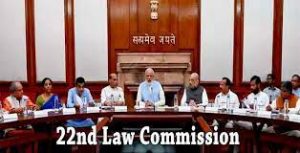
The Law Commission recently decided to solicit views from the public on the idea of a uniform civil code.
- Uniform Civil Code(UCC) refers to a common set of laws governing personal matters such as marriage, divorce, adoption, inheritance and succession for all citizens, irrespective of religion.
- Article 44: This Article of the Constitution makes a reference to a UCC and says, “The State shall endeavour to secure for the citizens a uniform civil code throughout the territory of India.”
- This is in the chapter dealing with the Directive Principles of State Policy and is therefore presumed to be advisory in nature.
- Article 37: States that the vision of a Uniform Civil Code (along with other directive principles) is enshrined in the Indian Constitution as a goal towards which the nation should strive, but it isn’t a fundamental right or a Constitutional guarantee.
22nd Law Commission:
- The Commission is headed by former Karnataka High Court Chief Justice Rituraj Awasthi.
- The Commission, among other things, shall “identify laws which are no longer needed or relevant and can be immediately repealed; examine the existing laws in the light of Directive Principles of State Policy and suggest ways of improvement and reform.
- suggest such legislations as might be necessary to implement the Directive Principles and to attain the objectives set out in the Preamble of the Constitution”; and “revise the Central Acts of general importance so as to simplify them and remove anomalies, ambiguities and inequities”.
- The Commission is also looking into several significant issues like
- Implementation of a Uniform Civil Code (UCC).
- Holding of simultaneous elections.
What Is Fish Kill?

Thousands of dead fish washed up on the beaches of southeast Texas due to a phenomenon called “fish kill,” which occurs when low levels of dissolved oxygen in the water cause suffocation of the fish.
- Texas is a state in the South Central region of the United States.
- It is the second-largest U.S. state by both area and population.
- The occurrence, known as a fish kill, resulted in the death of various fish species and has been attributed to specific environmental factors.
- The fish kill in Texas can be attributed to low oxygen levels in the water.
- When oxygen levels drop significantly, fish are unable to breathe, leading to suffocation and ultimately death.
- This situation is exacerbated when numerous fish are affected within a specific area over a short period.
- Several factors played a role in the Texas fish kill.
- Warm water temperatures reduce the amount of dissolved oxygen in the water, making it harder for fish to breathe.
- Additionally, calm seas prevent oxygen from being replenished through wind and waves, further exacerbating the oxygen depletion.




